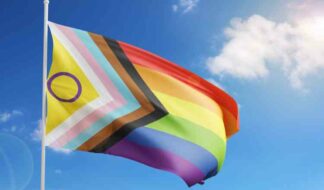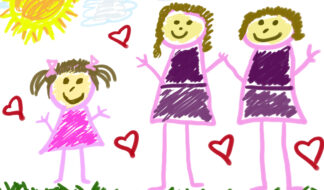by Jessica Carreras
Though her long hair, make-up and girlish style may say otherwise, Kristin Kurzawa wants all the drag kings of Detroit to know that she is, indeed, a lesbian.
The confusion began while the 39-year-old, a photographer and Masters of Fine Arts candidate at the University of Michigan, began taking pictures of the kings. With no crew cut or softball mitt in sight, they wrote the high-heeled artist off as a straight girl.
But she wants to set the record straight – er, gay – and with two upcoming solo exhibits, the femme photographer will do just that.
This weekend, Kurzawa's exhibit "Femmes Front and Center" will open at the SHaut Gallery and Performance Space in Ann Arbor. The photos will showcase women more like herself – a fact, she said, that made it much easier to photograph them. "The problem (with photographing drag kings) is that I identify as femme, and they didn't see me (as a lesbian)," she explains. "But with femmes, they see me automatically – so working with femmes, there was this instant bonding and kind of understanding."
Though Kurzawa has successfully photographed and exhibited both groups, the purpose of her latest exhibits (the second showing at Affirmations in May) is to show the beauty of femme culture and prove that femmes have both a vibrant history and a booming future in the LGBT movement.
Femmes in the spotlight
When Kurzawa went to the International Drag King Extravaganza in Columbus, Ohio last October, she had the stars of the show in mind for her photos. However, after seeing several femme performances, Kurzawa's focus shifted. "I was really drawn to the femme performances and the femme women on stage," she describes of the weekend. "That's where I started getting started and wanted to find images of femmes."
From there, Kurzawa spoke to advisors at her school and decided to not only continue photographing femmes, but to make the project her senior thesis. She researched the history of femme culture, traveled to New York to photograph more femmes and explored what it meant to make art out of her own community.
The resulting photographs will be displayed at SHaut through the end of March, and will focus on femme performance.
All the photos are live shots last October's conference, though her May exhibit at Affirmations will be a broader look at femme culture. "They're all live-action photographs as they are happening on stage," Kurzawa says of "Femmes Front and Center."
Though all tied together by performance, the photos range from dolled-up femmes to butch femmes to burlesque dancers – some in dresses and feather boas and others in no more than skimpy lime-green bikinis.
The point, she says, is to prove that femme identity does not fit into a neat little box, but can be expressed in many different ways by all shapes, sizes, ethnicities and personalities. "One of the things about my show that I wanted to do was to show all kinds of femmes," she adds. "There are femmes in my show that are not super feminine. One woman is wearing a T-shirt that says 'masculine femme,' which I love. One is doing burlesque. So it's all different."
Femmes then and now
The photos are as different and diverse, Kurzawa explains, as femme-butch culture itself, which has remained mysterious and largely indefinable, even to those who consider themselves to be part of it.
Kurzawa, for example, calls herself a "tomboy femme." She plays sports and is very independent, but loves to dress up, wear make-up and date butch lesbians.
Though traditionally, femmes were identified as feminine lesbians who date butch women, Kurzawa and many others believe that the spectrum has always been much broader than that.
Butch-femme identity dates back as far as the 1920s and '30s, and hit its peak in the 1950s, she says, with working class couples. Though the culture never disappeared, it has made a recent comeback. "I think I've seen a resurgence of it definitely within the last 10 years in the way people enact or live out the identities of butch and femme in their lives," Kurzawa says. "Butch-femme socials are happening all over the United States. There are butch-femme Web sites, butch-femme balls. It's never died down and it's still an exciting movement."
Kurzawa credits much of the revival to visibility of the femme culture in books, on the Internet and in the public eye. "Femmes have always been visible in terms of their role next to butches or in the way they dress with each other, but in the 21st century, femmes are taking a broader role as culture makers, as artists," she explains. "Femmes are outspoken as policy makers, as writers."
Moreover, Kurzawa, who came out in 1990 and grew up with a strong femme culture in Buffalo, N.Y. says that acceptance of what the term "femme" encompasses has increased. Femme is now a term owned by some gay men, trans people and women who don't fit into traditional femme norms. It could mean men who are only femmes when on stage, or defined by one's tendency to date butch lesbians.
"No one labels you femme. You label yourself femme," she insists. "Femme is more of a gender identity or a way you describe yourself."
The beauty of being femme
With both of her upcoming exhibits, Kurzawa hopes to showcase all types of femme identity with a magnitude they are often denied – both as part of the LGBT community, and in the performance sphere.
On stage, she laments that femme performers are often stuck in as filler between well-known acts and thus, are ignored by audiences.
"One of the things I hope they bring to light is that the femme experience – the femme performance – isn't just that little act that fills in between two drag king performances," she stresses. "I want people to stop and see the queer femme performance in its glory, that she really is this whole performer and the performance deserves attention for what it is."
And what it is, Kurzawa maintains, is beautiful – even though some may say otherwise.
Kurzawa admits that feedback to her photos ranges from awe and appreciation to disgust over the women depicted, many of whom are a far cry from the miniscule models of magazine pages. But Kurzawa doesn't mind shaking things up. "Seeing real-bodied women makes people nervous," she admits. "They ask why they aren't covered up, but that's exactly the point. We are big in terms of personalities, in terms of our size, we are in your face, we are loud sometimes and we deserve that moment.
"I don't want to just shock people, because that's not the point," she adds. "The point of it is to make people go 'Wow, look at her beauty.'"
For Kurzawa, that means accepting and appreciating beauty and femininity in all shapes, sizes and manifestations – not just in her art, but also in her own life. "Femme, to me, is more about being feminine, fierce and proud of who I am as a woman," she says, adding that she doesn't need to wear heels or make-up every day. "It's about being solid in my femininity and in my womanhood. I know that I'm a queer woman and I've got those powers if I need them, but I don't need to do that every day to just be who I am."
An artist. A student. And, of course, a femme – whatever that means.
Femmes Front and Center
SHaut Gallery and Performance Space, Ann Arbor
734-994-3677
March 7-30
"Femmes Front and Center" opens 6:30-8:30 p.m. March 7 with a reception at SHaut Gallery and Performance Space in Ann Arbor. A Butch-Femme Social will be held after the gallery opening from 9:30 p.m. to midnight. Both events are free and open to the public.









